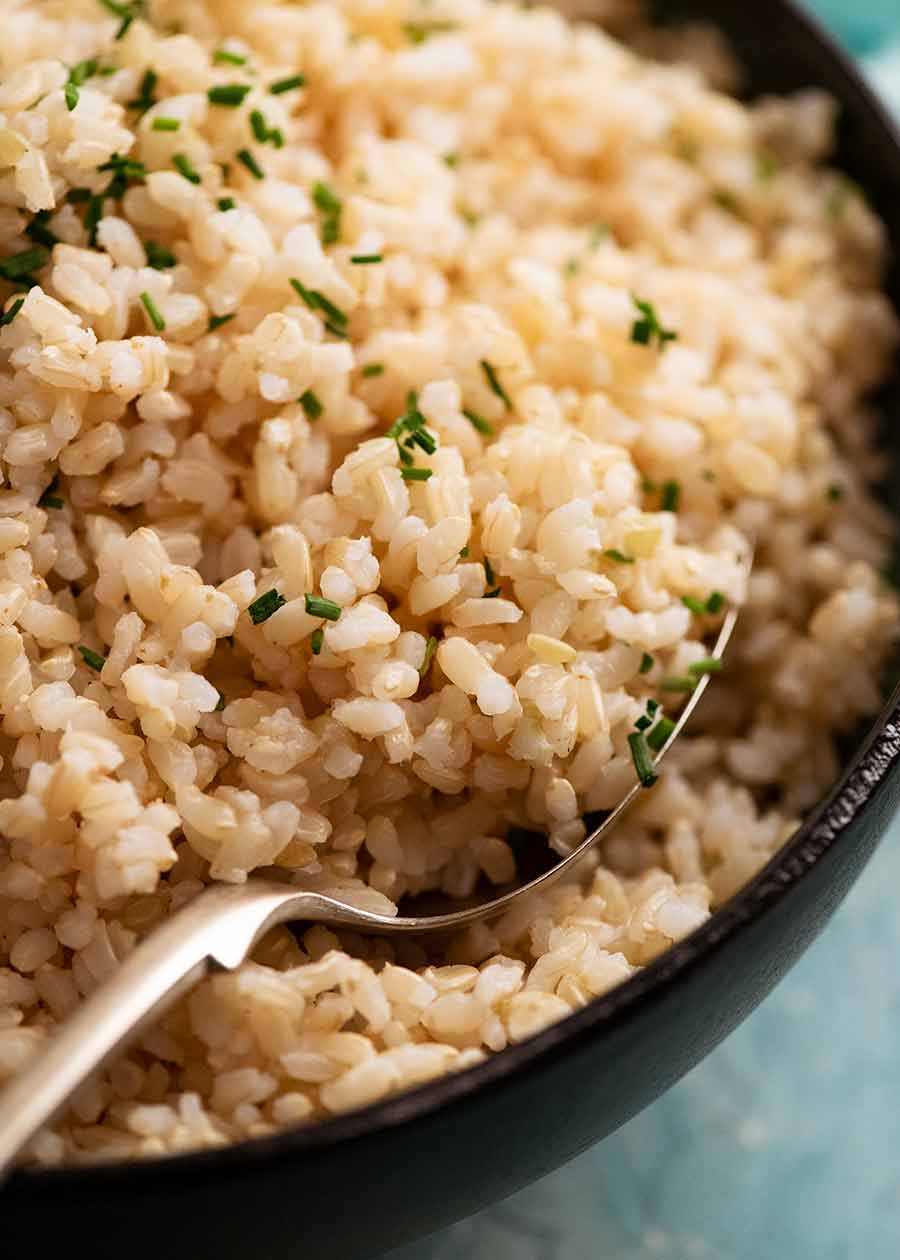
The best way to cook brown rice depends on what type of brown rice you have – and I cooked a LOT of brown rice to figure this out! Did you know brown basmati rice cooks in half the time of long grain, and short grain brown rice is better baked rather than cooked on the stove?
BIGGEST TIP – ignore the packet directions, and DO NOT use the absorption method!

This is a recipe for how to cook brown rice so it’s fluffy and cooked to perfection. When was the last time your brown rice came tumbling out of the pot like THIS??↓↓
The challenge with cooking brown rice is that it has a harder hull than white rice, being the nutritious bran layer than is left on during milling. So all too often, recipes will lead you down a path to either overcooked mushy surfaces with cooked insides, OR the surface might be perfect but the inside is still hard.
The brown rice cook time varies drastically depending on what type of brown rice you have.
Well, you can ignore all those other recipes you’ve used in the past. This is all you need to know about how to cook brown rice perfectly and consistently, every single time:
How to cook brown rice (perfectly)
- Determine what type of rice you’ve got; and
- Cook it according to the table below.
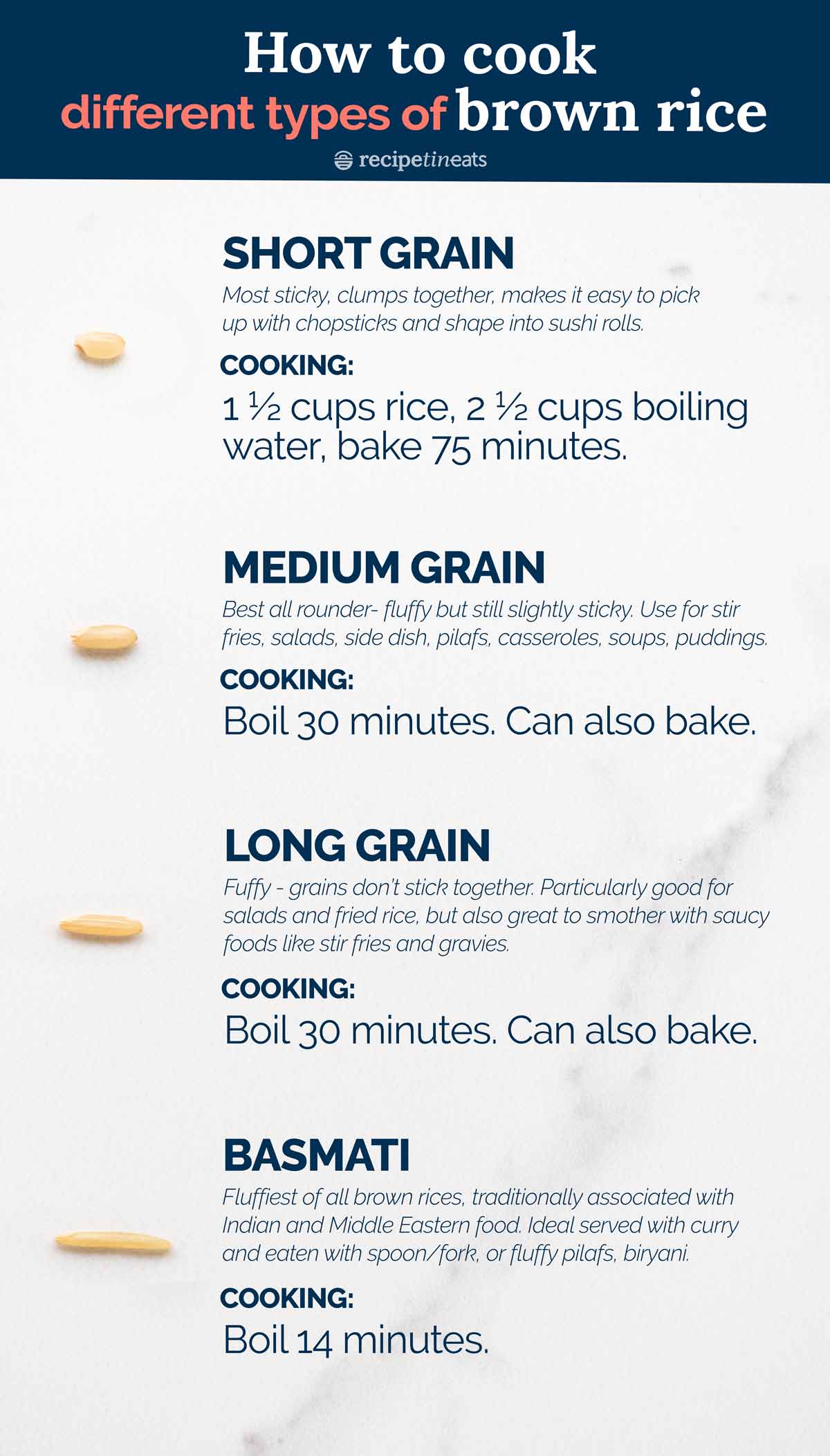
Using these methods, your brown rice will be….
- Perfectly cooked all the way through – not overcooked and mushy, nor undercooked in the middle;
- Will have a perfectly cooked surface that is neither gummy/slimy, nor unpleasantly wet and soggy;
- Will have the slight chew that we love about brown rice, from the layer of bran that is kept on during milling – the good stuff, the flavour and nutrition!
- Will be beautifully fluffy – if you used medium/long grain or basmati rice; or
- Will be a bit sticky and clump together as intended – if you used short grain rice.
If you don’t know what type of brown rice you have, match it as best you can to the photos above.
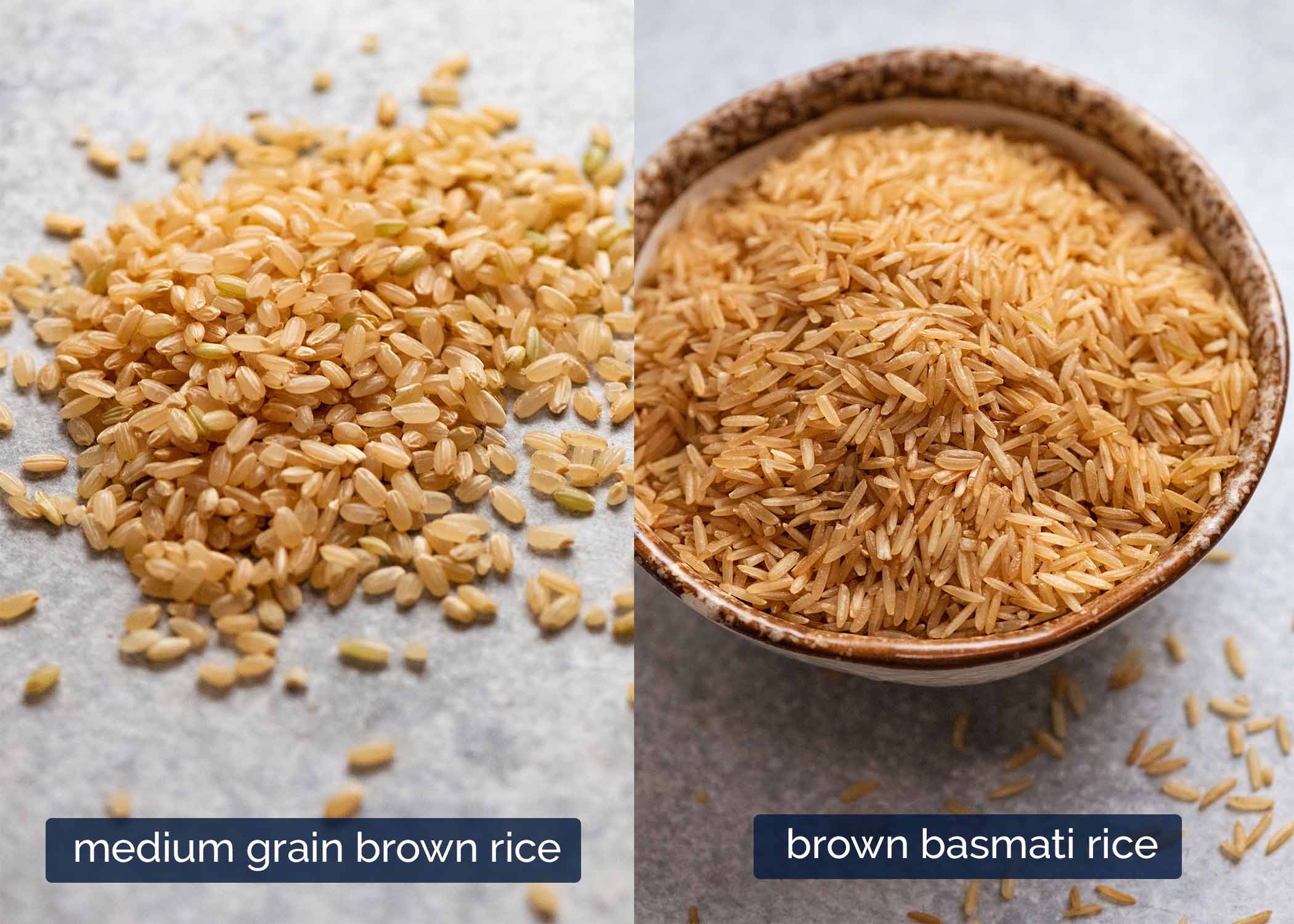
Boil and Drain
Use this for: medium grain, long grain and brown basmati rice.
Overview: This method is for long rice grains that cook up fluffy and separated, rather than clumping together. The rapid boiling keeps the grains agitated so they don’t stick together. This “hard and fast” boil method is ideal to cook through the tough, nutritious bran layer on the outside of brown rice.
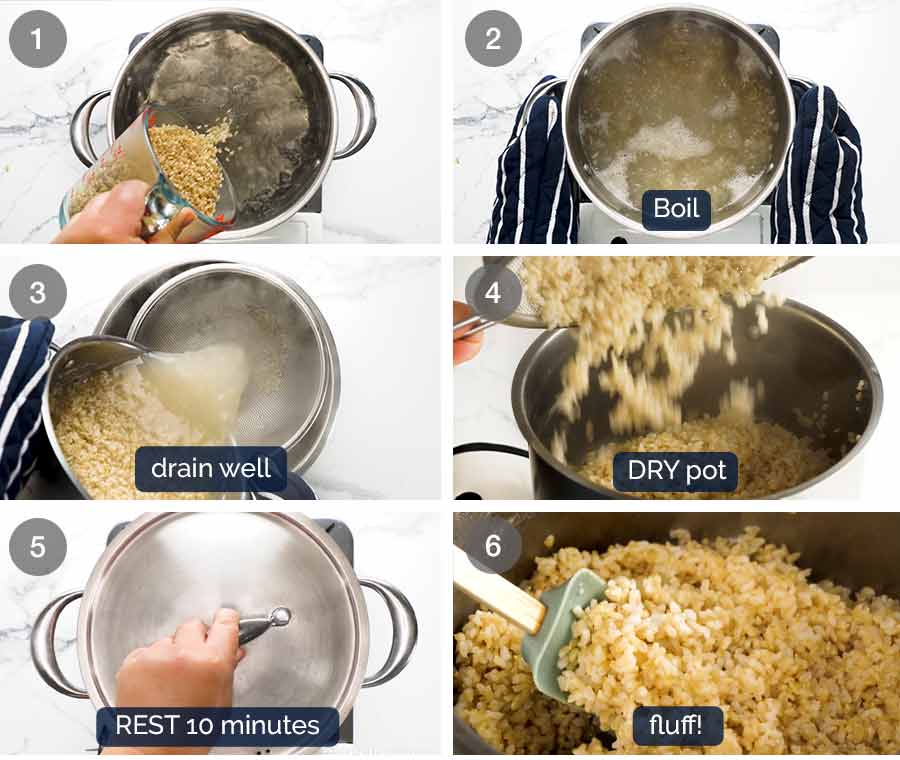
The Boil and Drain method is just like cooking pasta – with one very important difference: resting. When the rice is drained, you will notice the grains are unpleasantly soggy. When you return it to the pot and leave it covered for 10 minutes, the grains will absorb the excess water and transform into fluffy perfection!
A KEY STEP many recipes get wrong
Take care to shake off excess water well when you drain the rice, and to tip out every drop of water from the pot so it steams dry with the residual heat. If you have a slick of water left on the base of the pot when you tip the rice back in, the rice will absorb that water and end up over bloated.
Also, make sure to put the pot back on the turned off stove while the rice is resting. That extra little bit of residual heat will help the rice “steam dry” to perfection.
This is brown basmati rice that’s been cooked using the Boil and Drain method:

Baking Method
Use this for: short grain. Also very good for medium grain and long grain (though Boil and Drain is better for these).
Overview: Excellent entirely hands off method to evenly cook through brown rice. Marginal bits of crispy brown rice on the rim of the surface, but it doesn’t bother me in the slightest. (In fact, I want to pick them off for myself!)
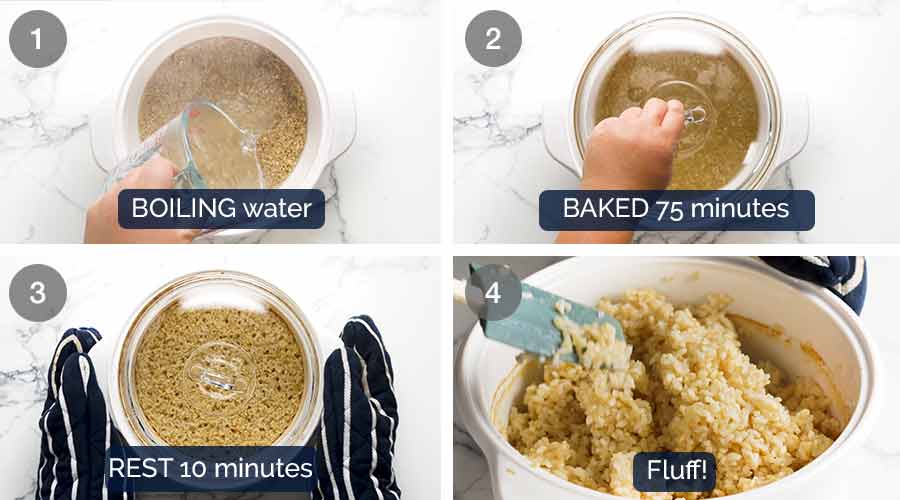
This massively overlooked method of baking rice is ideal because the baking vessel is not in direct contact with the heating element (like with stovetop cooking) so you don’t have to worry about a scorched base, and the long, slow 75 minute cook time allows for the tough outer layer of the brown rice to cook through perfectly.
Key Step: BOILING water
It is important to use BOILING water not cold tap water for the baked method. Otherwise it takes a good 15 minutes or so for the water to heat up enough to start cooking the rice during which the rice is just wallowing and bloating in warm water, resulting in mushy rice.
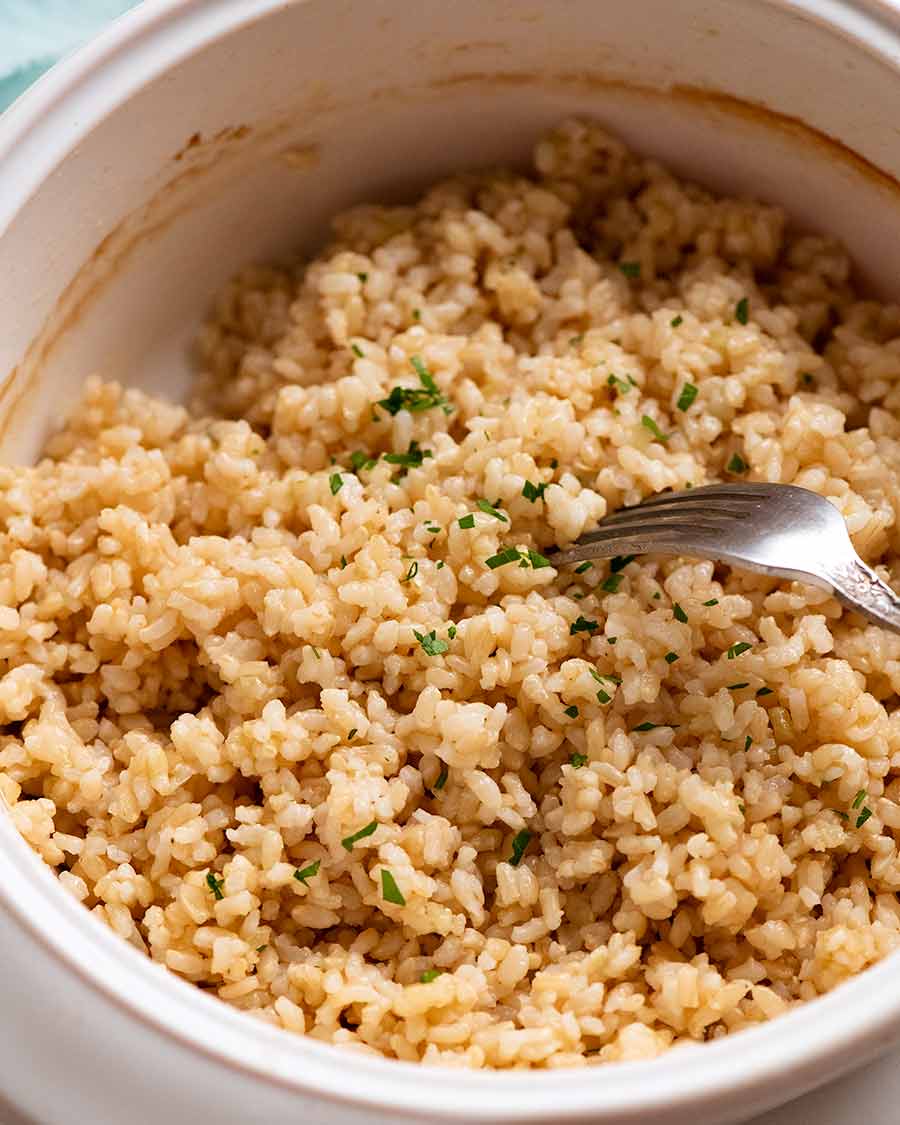
Different types of brown rice
Technically, any rice that doesn’t have the hull removed is a brown rice, so this includes things like red rice, black rice etc. But for the purpose of this recipe, I’m covering the four common types of brown rice (all pictured in graphic at top of post):
- Short grain brown rice rice – short and stubby, this cooks up sticky so the grains clump together, making it ideal to pick up with chopsticks and use for things like sushi where you want the rice to stick together. This is rare in Australia, I’ve only used it a handful of times, always from speciality stores or markets. Most sushi shops in Australia use medium grain brown rice;
- Medium grain brown rice (below left) – slightly longer than short grain, this is a great all rounder that is slightly stickier than long grain, but not as sticky as short grain (just sticky enough to make sushi rolls). Most common rice type in Australia;
- Long grain – longer still, cooks up fluffy and doesn’t stick together as much (though it still does a bit). Ideal for salads (think – tossing with dressing); and
- Basmati (below right) – the least sticky of them all! Traditionally from the Indian sub-continent so ideal with all things curry as well as Middle Eastern foods.

When to use which rice?
When used cooked – like serving with stir fries, or in rice salads and rice soups – the type of brown rice doesn’t really matter except for things like sushi when the rice needs to stick together (use short grain).
However, it does matter when uncooked rice is used in a recipe because the cook time and liquid amounts required depends on the type of brown rice used. The recipe author should (hopefully!) specify which type of rice to use.
Pro tip: you get what you pay for
Not all rice is created equal. If you buy economical house-brand rice, it will not taste as good as the premium brands. This is particularly prevalent with basmati rice – the cheaper brands will always taste more “crumbly” and almost watery, whereas premium quality has a much definitive, pleasant texture and flavour. This applies to both white and brown rice.
I am in Australia and I typically use SunRice (Australia’s largest rice producer) which is a very good quality for everyday purposes.
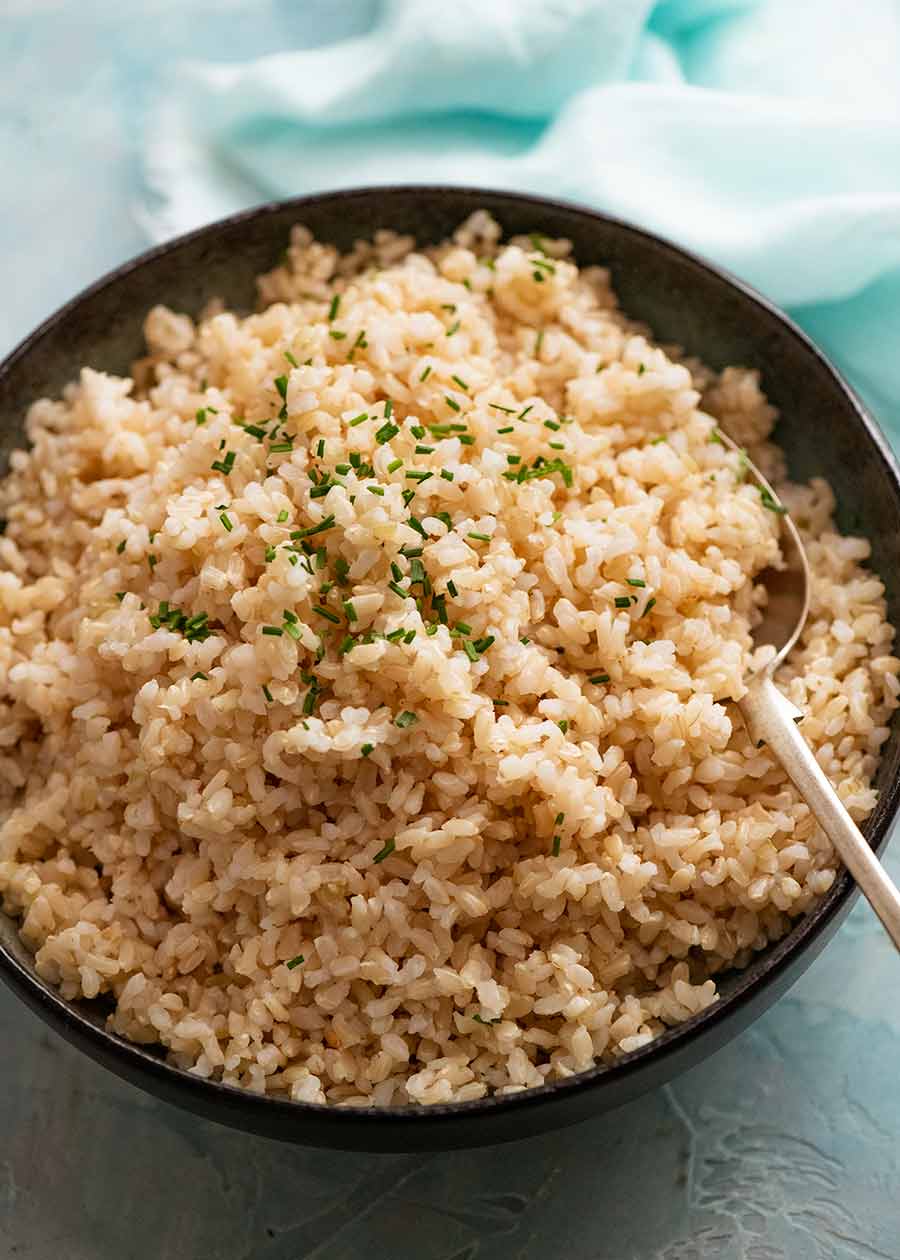
What to make with brown rice
Ahh, the possibilities in your newfound perfectly-cooked-brown-rice life!! To smother in stir fries, make fried rice, rice salads, and the hundreds of recipes on my website that end with the words “serve with rice”.
Basically, anytime a recipe calls for using or serving with cooked white rice, switch it out with brown rice for the added health benefits and flavour!
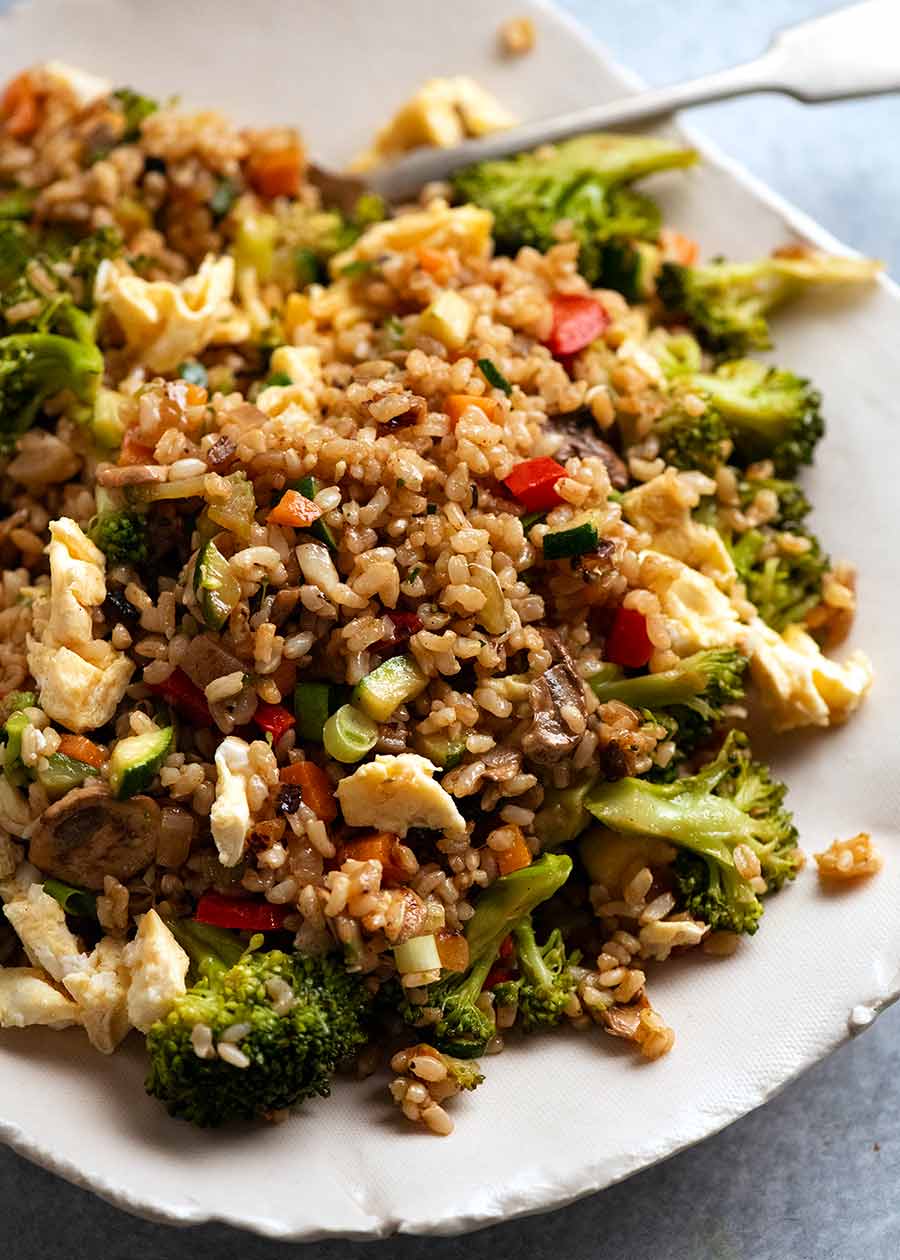
PRO TIP: Fried rice is excellent made with brown rice because the grains are a little firmer than white rice so you don’t even need to refrigerate overnight! I have quite a few for you to choose from:
FRIED RICE RECIPES to make using brown rice
Also, if you clicked on the brown rice testing matrix and are wondering what on earth I did with all that rice (especially the many batches of mushy rice!), it just so happens that Dozer’s homemade dog food includes soft cooked brown rice so it all went to him!
That’s why I didn’t mind experimenting – because I knew none would go to waste. As a child, we were scolded for leaving a single grain of rice in my bowl. “A rice farmer picked that with his bare hands!” my mother would tell us, guilting us into respecting every grain of rice.
I do think that even back then, the farmers had a little help from machinery.  But it was still a lesson well learned! – Nagi
But it was still a lesson well learned! – Nagi
Watch how to make it
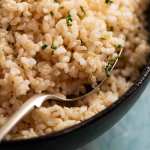
How to cook brown rice (finally, a recipe that works!)
Ingredients
Boil and Drain (for fluffy rice):
- 1 cup medium grain, long grain or basmati rice
- 8 cups water (Note 1)
Baked Rice (for stickier rice):
- 1 1/2 cups short grain brown rice (medium grain ok too)
- 2 1/2 cups BOILING water (Note 2)
Recipe will NOT work for (or not yet tested for) the following rice types:
- Quick cooking rice (ie par boiled) - will not work
- Brown sushi rice, brown jasmine - not yet tested (haven't come across them)
Instructions
Before you start:
-
Determine what type of brown rice you have.
-
THEN determine the cooking method by looking at the ingredients list above.
-
Boil and Drain First Timers, or if using a new type or brand of rice, always check the rice (very!) early to see if it's cooked. Rice goes from soft to overcooked in mere minutes!
Boil and Drain:
-
Boil water: Bring water to a boil in a small pot or large saucepan over high heat.
-
Boil rice: Add rice, then boil rice until just cooked, a tiny bit firmer than you want (it gets softer during Rest step). Use these times as a guide (Note 3): - Medium and long grain rice: 30 minutes - Basmati rice: 12 minutes (1st check) to 14 minutes
-
Drain VERY well (key tip! Note 4): Drain rice well in a colander, shaking the pot and colander to remove as much water as you can from the rice and pot. Pot should steam dry from residual heat.
-
Rest: Return rice to now-dry pot. Put lid on and put it back on the turned off stove. Leave for 10 minutes.
-
Fluff and serce: Fluff rice with fork and serve.
Baked Rice:
-
Preheat oven to 180°C/350°F (all oven types).
-
Combine rice and water: Pour rice and boiling water into a 20cm/8" square pan or round casserole pot. Cover with lid or foil.
-
Bake 1 hour 15 minutes.
-
Rest, fluff & serve: Remove from oven, stand 10 minutes then fluff with fork and serve.
Notes
- Short grain - this sticky rice is best baked. Boil and drain isn't suitable for sticky rice.
- Medium grain - sits between sticky short grain rice and fluffy long grain rice. Boil and Drain is best (fluffiest result) but baked is very good too (useful hands-off method).
- Long grain and basmati - these long slender grains of rice are most definitely best cooked using the Boil and Drain method for the fluffiest result. Baking works too, but the texture of the rice at the base ends up stickier than ideal, while the rice on the surface is closer to what it should be.
1. Water volume - as you scale up the recipe, you don't need to scale up the water volume as much. You just need plenty of water that the rice can absorb (it will almost triple in volume) and enough extra bubbling water to keep the rice bouncing around. Think of it like pasta! So for 1 cup rice, you need 8 cups water, but then for 2 cups of rice, you need only 12 cups of water. And so on. 2. Boiling water - important to use boiling water to skip the time it takes for water to heat up in the oven. If you don't use boiling water, the rice is just soaking in water for 20 minutes or so until it starts cooking, and you'll end up with soggy rice (as well as increasing cook time). 3. Why are boil times only a guide? Because I've found that from brand to brand, the perfect cook time can differ. It's utterly frustrating! But there seems to be no universal standard for brown rice grain sizes, and rice can go from perfect to overcooked in mere minutes. So the golden rule is - CHECK EARLY! (And once you've perfected your preferred rice brand, you'll know the perfect boil time - stick it on your fridge!). 4. Excess water - shaking off excess water from rice and pouring out every drop of water from the pot so it steams dry in seconds with the residual heat are two key tips for perfect rice using the Boil and Drain method. If the rice is soggy or if the base of the pot is covered in water when you return the rice to the pot, it will absorb that water and end up over bloated. Resting rice after cooking is especially critical for Boil and Drain because the rice is "wet" straight out of the pot. During the resting phase, the water on each rice grain gets absorbed into the rice, leaving you with perfect rice grains! 5. Nutrition per serving, assuming 1 cup of uncooked rice serves 3 people.
Nutrition
Life of Dozer
I went searching for a photo of Dozer’s homemade food mix which includes soft cooked mushy brown rice (the perfect use for all the failed batches of brown rice!). This is the only one I could find – from that time I was putting his bowl together and a bit of his food flew into my mouth!! 
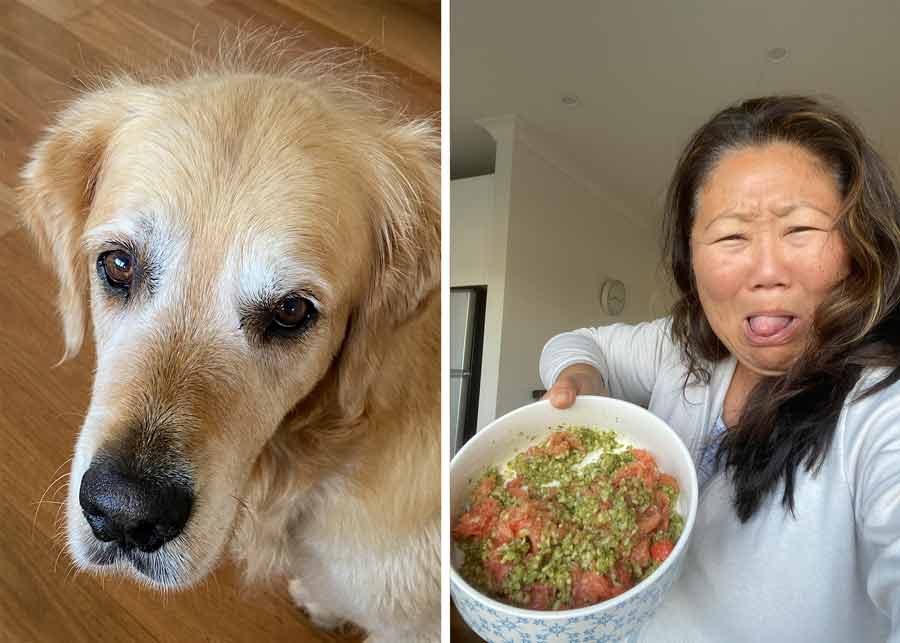
For those who are interested, here is his homemade dog food recipe, but please do not use it without consulting your own specialist or doing your own research because I am not an expert (only an expert on Dozer’s food!).
The post How to cook Brown Rice (the last you’ll ever read!) appeared first on RecipeTin Eats.
from RecipeTin Eats https://ift.tt/33t5olR
via IFTTT

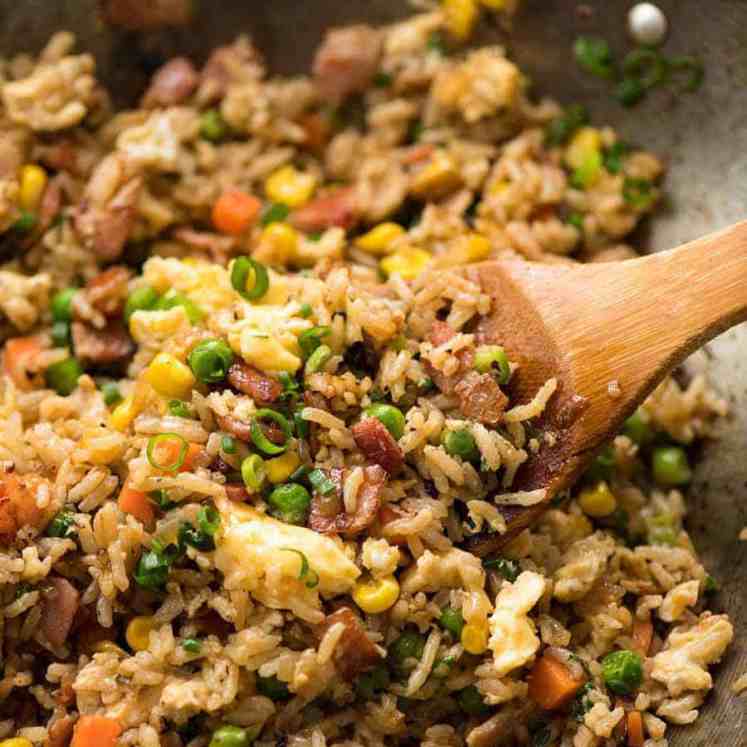
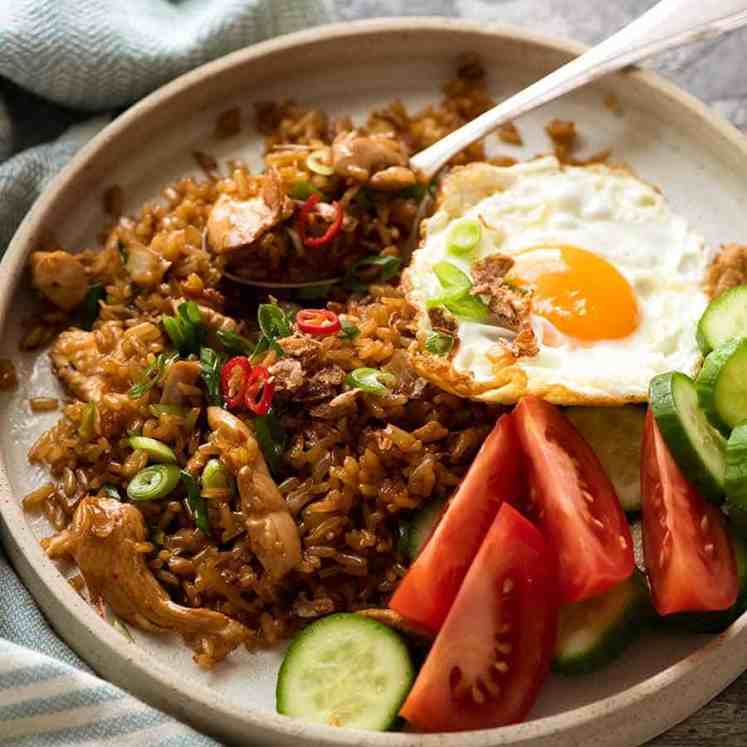
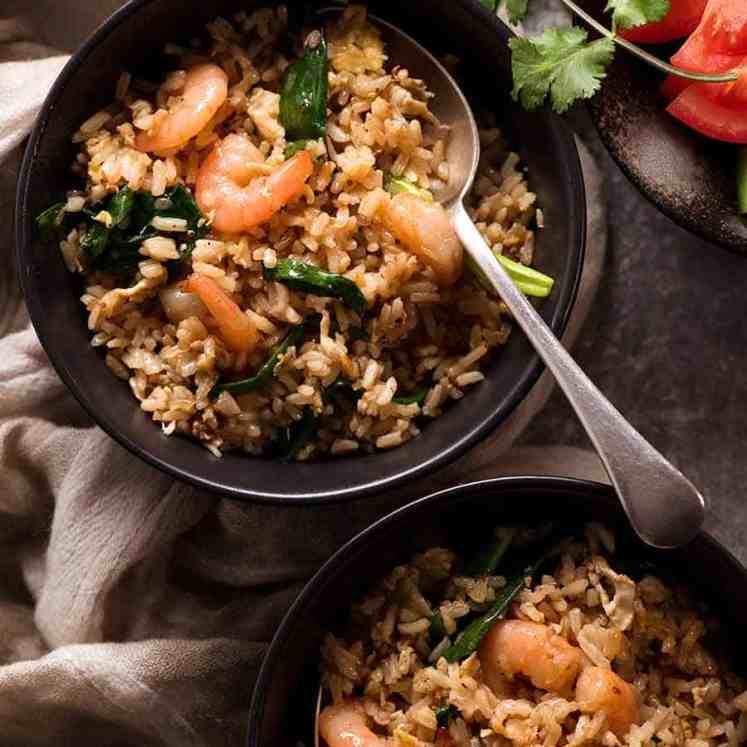
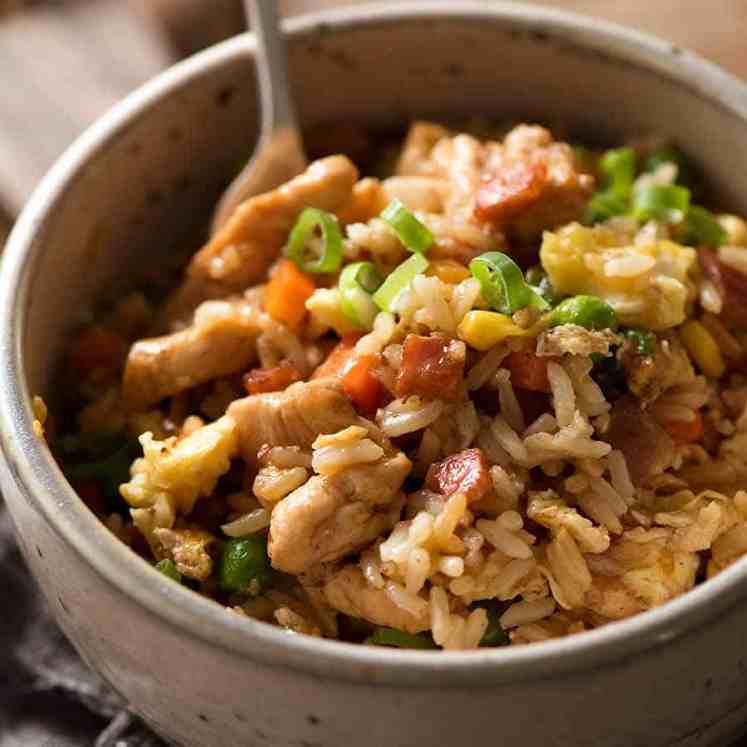
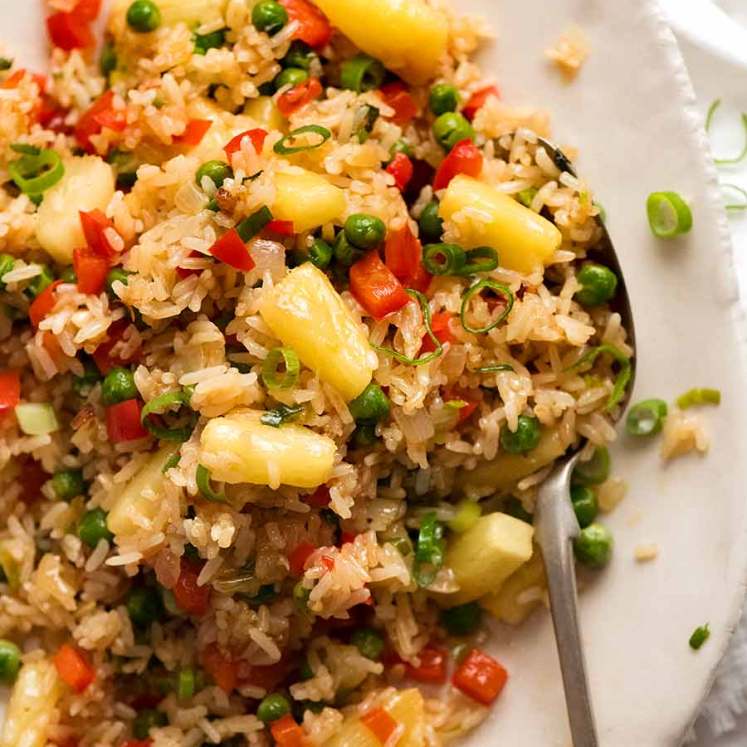
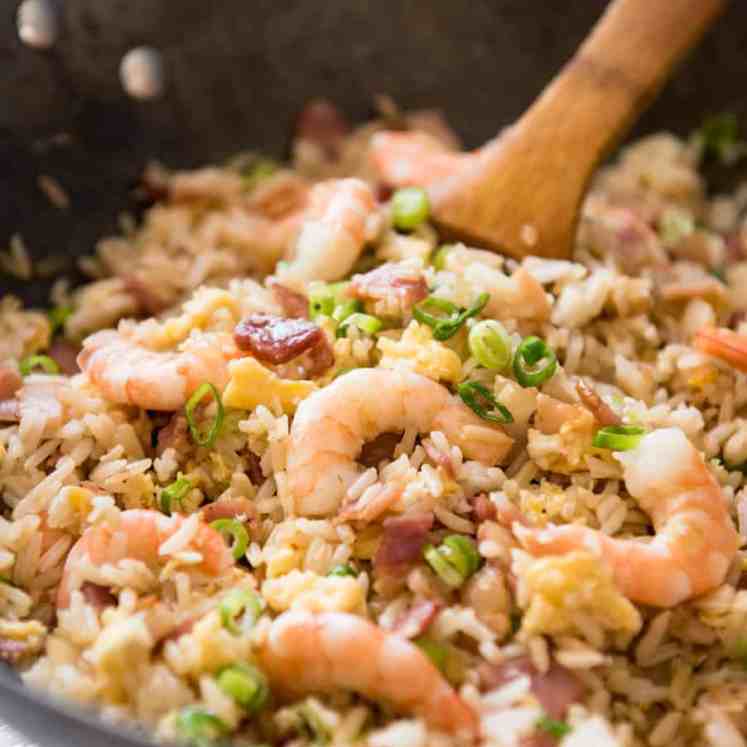




No comments:
Post a Comment